MRS Spring 2024
Join us at the 2024 Materials Research Society (MRS) Spring Meeting, where PNNL researchers will present the latest findings in materials sciences.

(Image by Shannon Colson | Pacific Northwest National Laboratory)
The Materials Research Society (MRS) Spring 2024 Meeting will be held April 22–26 in Seattle and provides a window into the future of materials science. The virtual portion of the Meeting is May 7–9.
Visit Pacific Northwest National Laboratory (PNNL) at MRS Spring at booth #221.
Scientists from PNNL will be joining their peers from around the world to discuss topical clusters including Broader Impact (BI); Characterization (CH); Electronics, Optics and Photonics (EL); Energy Generation and Conversion (EN); Energy Storage (ES); Manufacturing (MF); Materials Theory, Computation and Data Science (MT); Nanomaterials (NM); Quantum Materials and Materials Physics (QT); Soft Materials and Biomaterials (SB); and Structural and Functional Materials (SF).
Many researchers from PNNL will be participating in this year's conference. View the list of some featured presentations below.
News
Research done by Qingpu Wang, Elias Nakouzi, and Chinmayee Subban, Selective and Sequential Precipitation for Critical Mineral Extraction from Electronic Waste (EN06.10/EN03.10.04) (April 25), is featured in the news release, "Critical Mineral Recovery from Electronic Waste."
Key Sessions and Symposia
- Dongsheng Li organized the symposium Characterizing Dynamic Processes of Materials Synthesis and Processing via In Situ Techniques (CH01), while she and Jim De Yoreo, Battelle Fellow at PNNL and affiliate professor of materials science and engineering at the University of Washington, are its session chairs. Li is also a chair for five other sessions in the Meeting. (April 23–26 and May 7)
- Yaobin Xu organized a symposium and is chairing sessions for Utilizing Advanced In Situ/Operando Transmission Electron Microscopy and Spectroscopy for the Investigation of Functional, Energy and Quantum Materials (CH02). (April 23–26)
- Wu Xu organized the Metal Anodes in Rechargeable Batteries—Electrolyte, Interface and Mechanism (ES04) symposium and is chairing four of its sessions. (April 24–26)
- Ruozhu Feng is symposium organizer for Materials Challenges for Flow-based Energy Conversion and Storage (ES05) and chair of five of its sessions. Wei Wang is chairing one session with Feng. (April 24–25 and May 9)
- Dongping Lu organized Sulfur and Sulfide Chemistry in High Performance Electrochemical Energy Storage Symposium Organizer (ES06) and is chair for five of its sessions, Metal Anodes in Rechargeable Batteries—Electrolyte, Interface and Mechanism (ES04), Materials Challenges for Flow-based Energy Conversion and Storage (ES05), and Sulfur and Sulfide Chemistry in High Performance Electrochemical Energy Storage (ES06). (April 23 and 25 and May 7)
- Steven Spurgeon is a panelist for a Focus on Sustainability Session on Materials Needs for Energy Sustainability by 2050: AI-assisted Materials Development for a Sustainable Future. (April 25)
If you're looking for a career in materials sciences, check out our current openings:
Selected PNNL Presentations
View a list of all PNNL presentations in the PNNL's 2024 MRS Spring presentations.
Tuesday, April 23
An In Situ look at Interfacial Structure and Dynamics during Nucleation and Self-Assembly

Presenter: Jim De Yoreo
10:30–11:00 am PT, April 23, Room 442, Level 4, Summit
Summary: Interfaces play a critical role in nucleation and growth from solutions by altering the distribution of water and ions from that of the bulk, introducing an interfacial free energy that largely determines the free energy barrier to nucleation, and creating an entropic repulsion that acts as a volume exclusion force to drive colloidal assembly. The origin and characteristic length scales of these phenomena are inherently atomic-to-molecular but are manifest in ensemble dynamics and outcomes. Moreover, processes like nucleation and self-assembly arise from fluctuations, making the events that must be probed transient in nature. Consequently, in situ imaging techniques that can capture structure and its evolution, particularly at high speed and atomic-to-nm resolution, are required to build a quantitative picture of such processes. Read more.
Data-driven Research for Aqueous Organic Redox Flow Batteries
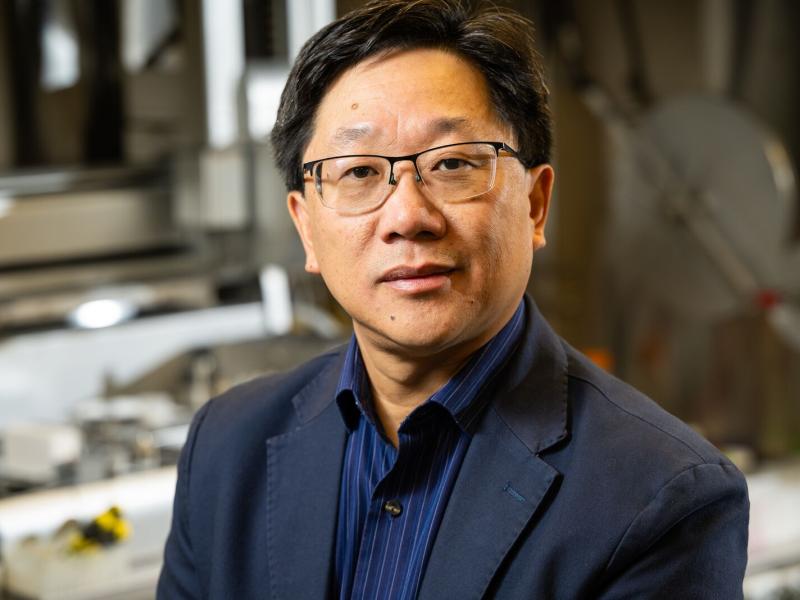
Presenter: Wei Wang
2:30–3:00 pm PT, April 23, Room 321, Level 3, Summit
Summary: Aqueous organic redox active materials have recently shown great promise as alternatives to transition metal ions as energy-bearing active materials in redox flow batteries for large-scale energy storage due to their structural tunability, cost-effectiveness, availability, and safety features. However, development to date has been limited to a small palette of aqueous soluble organics. This presentation will provide an overview of a data-driven approach to accelerate the discovery and development of aqueous organic redox-active molecules for flow batteries, including database curation, structure-property correlation, and automated property characterization and performance testing developed in PNNL’s ARES (Automated Robotics for Energy Storage) lab. Read more.
Single Crystal Ni-Rich Cathodes for Advanced Li-Ion Batteries
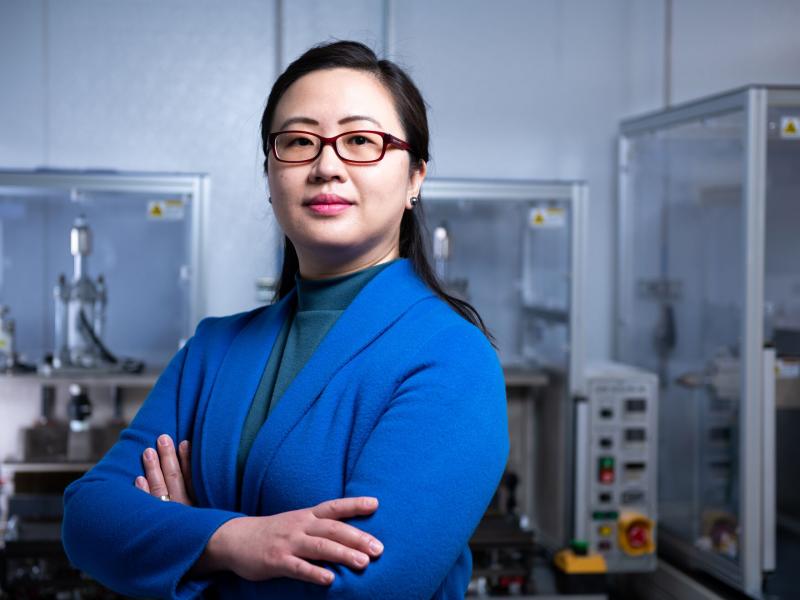
Presenter: Jie Xiao
2:30–3:00 pm PT, April 23, Room 425, Level 4, Summit
Summary: High-energy Ni-rich cathodes will play a key role in advanced Li-ion batteries, but they suffer from moisture sensitivity, side reactions, and gas generation. Single crystalline Ni-rich cathodes have significant potential to address the challenges present in their polycrystalline counterparts by reducing phase boundaries and materials surfaces. However, synthesis of high-performance single crystalline Ni-rich cathodes is very challenging. This talk will discuss a cost-efficient drop-in approach to synthesize and scaleup high-performance single crystal Ni-rich cathode materials enabled by nanoscale phase segregation during the calcination process. Read more.
Fe Substitution Suppresses Oxygen Vacancy Formation and Stabilizes High-Valence Ni in Epitaxial La0.5Sr0.5Ni1-xFexO3-δ Thin Films
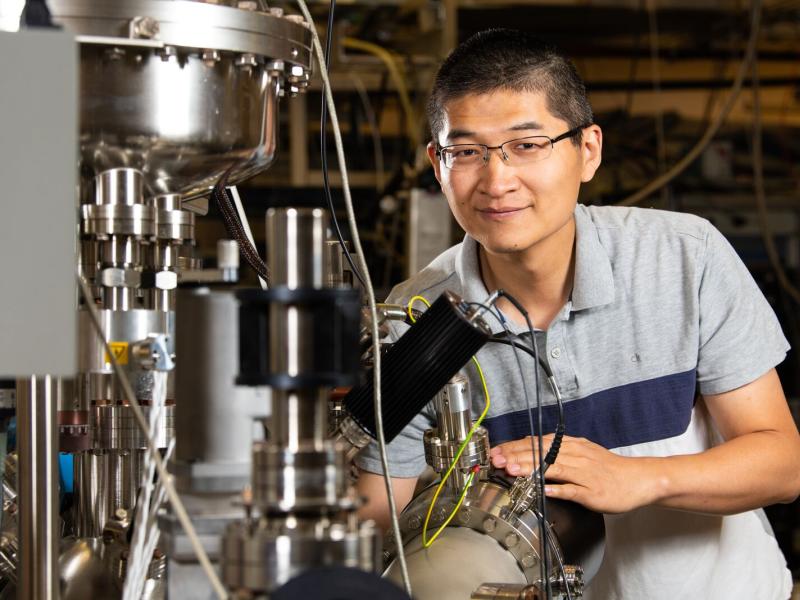
Presenter: Le Wang
4:00–4:15 pm PT, April 23, Room 343, Level 3, Summit
Summary: Recent discovery of superconductivity in Nd0.8Sr0.2NiO2 has inspired further exploration of nickelates to gain insights into the origins of high-temperature superconductivity. However, the synthesis of Sr- or Ca-doped nickelate thin films is challenging due to the instability of high-valence Ni and the competition between perovskite and Ruddlesden–Popper (RP) phases. Our recent study revealed that Sr doping in LaNiO3 thin films significantly reduces the Ni valence from Ni3+ to Ni2+ and results in the formation of numerous RP phases as the Sr doping level increases from 0% to 100%. Furthermore, DFT simulations on the La1-ySryNiO3-δ perovskite structures indicated a substantial decrease in the oxygen vacancy formation energy from 2.96 to 1.85 eV as y varies from 0 to 0.5. Read more.
Wednesday, April 24
Integrating Multi-Functionality that enables In-Situ TEM probing of Solid Electrolyte Interphase Characteristics
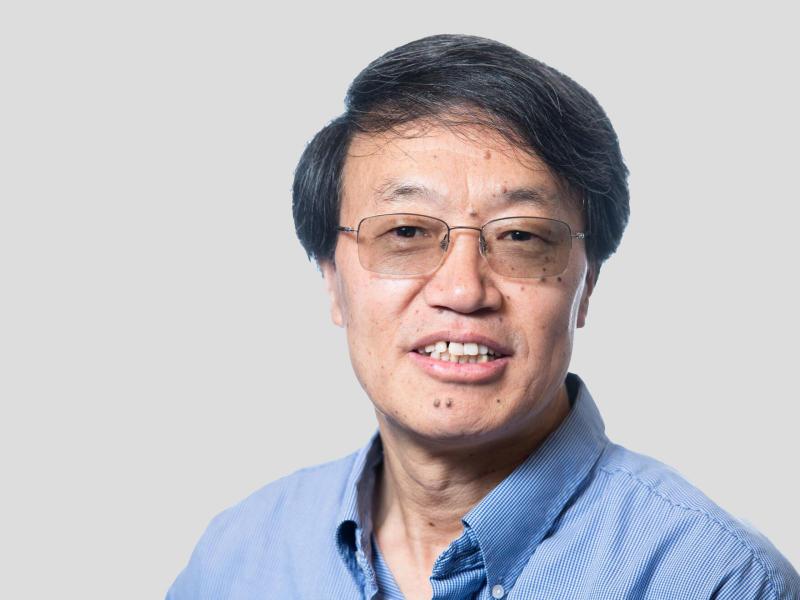
Presenter: Chongmin Wang
8:30–9:00 am PT, April 24, Room 422, Level 4, Summit
Summary: For better battery performance, the solid electrolyte interphase (SEI) layer is expected to possess three ideal characteristics: electrically insulative, ionically conductive, and constant thickness. These three characteristics are interactively correlated, typically, and the thickness of the SEI layer is controlled by the electrical properties of the SEI layer. However, SEI layers do not seem to behave with ideal characteristics—rather, the thickness of the SEI continuously increases during charge-discharge cycling and shelf storage, indicating that the SEI does not behave as an electrical insulator. We use in situ bias transmission electron microscopy to directly measure the electrical properties of the SEI. We discover that the current-voltage characteristics of SEIs resemble certain electrical conductance, rather than electrical insulation as conventionally assumed. Read more.
Formation of Highly Branched Nanocubes through Multi-Stage Oriented Attachment of Pt Nanoparticles
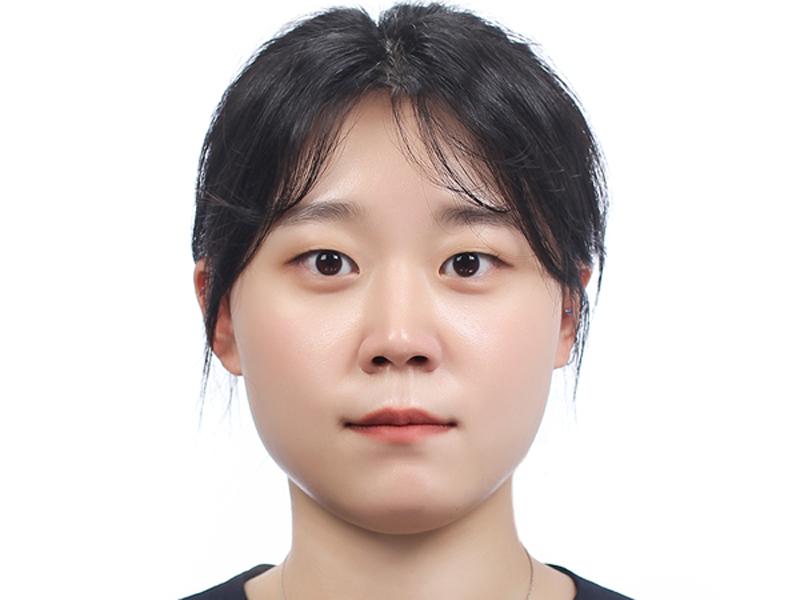
Presenter: Yuna Bae
9:00–9:15 am PT, April 24, Room 442, Level 4, Summit
Summary: Crystals grow through various pathways, such as monomer-by-monomer addition and attachment processes among ions, amorphous or crystalline particles, and clusters. Oriented attachment is a common path for crystal growth. The process of particle attachment is determined by the interplay between particles, i.e., interparticle forces, including vdW attraction, hydration repulsion, steric hindrance, and electrostatic interactions, which depend on the liquid-solid interfacial structures at particle surfaces. Herein, we investigate the formation process of branched Pt nanocubes via oriented aggregation of nanoparticles using a combination of cryo TEM, liquid-phase TEM, and simulations. Initially, primary nanoparticles of 2 to 3 nm in size are generated and then agglomerated to form a cluster. This cluster will further grow through nanoparticle and cluster aggregation. Read more.
Thursday, April 25
Selective and Sequential Precipitation for Critical Mineral Extraction from Electronic Waste
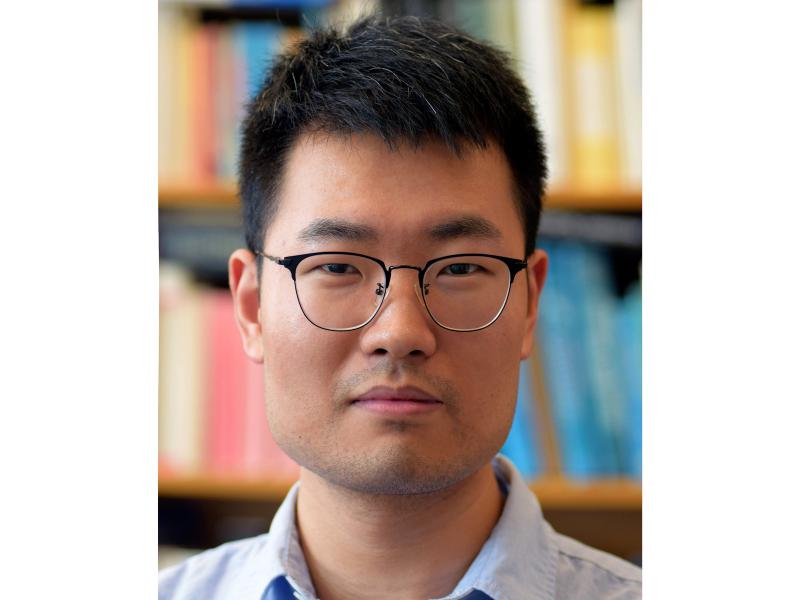
Presenter: Qingpu Wang
11:30–11:45 am PT, April 25, Room 333, Level 3, Summit
Summary: Recycling of critical materials from electronic waste (e-waste) shows great potential for urban mining. However, conventional separation methods are often chemical- and energy-intensive because they mainly rely on organic ligands, ionic liquids, and ion-selective membranes and/or electrodes. The sustainable production of valuable critical elements from e-waste requires a paradigm shift away from currently used resource-intensive processes. We present a novel approach based on the coupling of ion diffusion and precipitation kinetics. Simply by placing a mixed salt solution on top of a hydrogel loaded with a precipitating agent, we obtained spatially separated precipitates along the reactor. Our proof-of-concept has been demonstrated for sequentially precipitating transition metals with modeled feedstocks representative of lithium-ion battery cathodes and rare earth elements from NdFeB permanent magnets. We expect this approach to be broadly relevant to chemical separations from complex feed streams and diverse chemistries—enabling more sustainable materials extraction and processing. Read more.
Exploring The Photochemistry and Bonding of Trivalent Americium within Metal–Organic Constructs

Presenter: (Robert) Gian Surbella III
Contributors: Ana Arteaga and Aaron Nicholas
1:30–2:00 pm PT, April 25, Terrace Suite 2, Level 4, Summit
Summary: Metal-organic frameworks (MOFs) are suitable platforms for studying the fundamental properties of the transuranium (TRU) elements. While the material properties that are common to MOFs (e.g., structural variability, high surface area, and permanent porosity) are often exploited for their functionality, our motivations for studying TRU-MOFs are fundamental in nature. These robust, crystalline constructs are attractive hosts for immobilizing the scarce and often highly radioactive isotopes of the TRU elements, providing both structural stability and a platform to explore structure–property relationships. The trivalent lanthanide (Ln(III)) containing MOF-76 family is of particular interest in this regard, given its high thermal stability and unique optical properties, which have been explored for use in color tuning and analyte sensing. Read more.
Towards Atomic Precision in Superconducting Qubits: Mechanisms of Ta Oxidation and Strategies for Oxidation Suppression
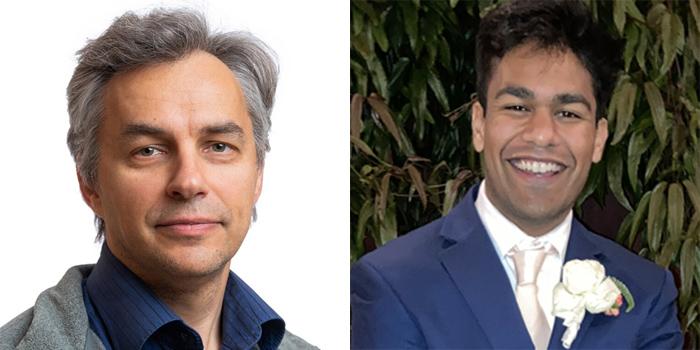
Presenter: Peter Sushko
Contributor: Jeffrey Dhas
4:30–4:45 pm PT, April 25, Room 445, Level 4, Summit
Summary: Coherence times of transmon devices can be affected by oxidation of the components made of superconducting metals, such as Nb and Ta. Spontaneous oxidation results in the formation of suboxide phases and surface amorphization that contribute to dielectric losses that are primarily attributed to two-level systems within such native oxide layers. Mitigating undesirable effects of surface oxidation requires understanding the mechanisms of interfacial interactions at the atomic scale. We review recent experimental studies that provide new insights into the atomic structure and composition of the native oxide layer and focus on ab initio simulations of the mechanisms of Ta interaction with oxygen. In particular, we consider energetics and pathways of the early stages of the Ta(110) surface oxidation, including propagation of the oxidation front into the Ta subsurface and corresponding electronic structure changes. Read more.
Friday, April 26
Promoting Room Temperature Aluminum Deposition Through Rapid Ligand Exchange Complexes
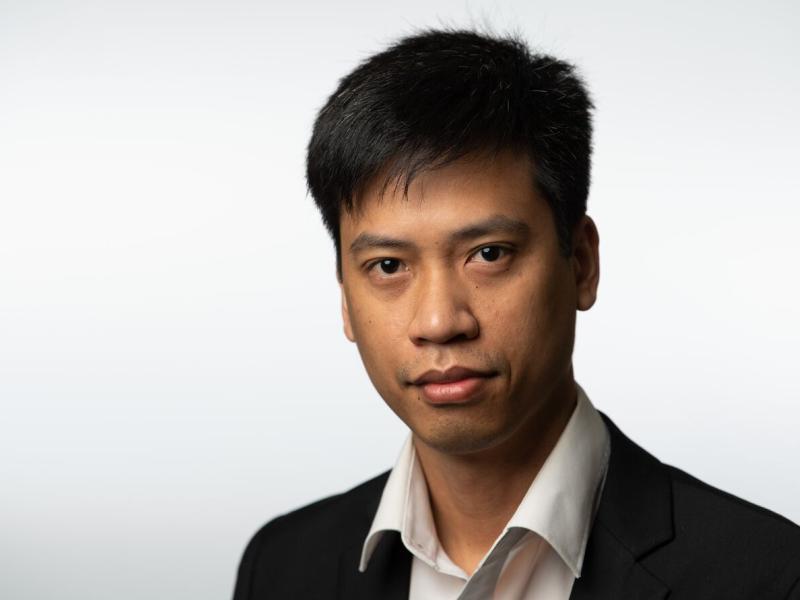
Presenter: Dan Thien Nguyen
11:30–11:45 am PT, April 26, Room 422, Level 4, Summit
Summary: Unlocking room temperature aluminum (Al) electroplating stands as a promising avenue for advancing multivalent energy storage systems and pioneering surface coating methods, pivotal in driving a zero-emission economy. Despite its potential, challenges such as electrolyte-induced parasitic reactions during Al deposition, high flammability risks, suboptimal Coulombic efficiency, and the costliness of organic-based electrolytes have persisted. Addressing these challenges necessitates reducing activation energy and expediting kinetics for the electrochemical reduction of aluminum cations in organic electrolyte solutions. This is pivotal for achieving efficient, reversible room-temperature electrodeposition of Al. In our study, we introduce a novel electrolyte material—a highly concentrated aluminum chloride (AlCl3) solution within weakly coordinating dialkyl-ether and sulfone compounds. These solvents swiftly form ligand exchange complexes with AlCl3, enabling rapid Al electrodeposition at a minimal 0.2 V overpotential. Read more.
For more information about physical and computational sciences at PNNL
Click on the flyers below to learn about our physical and computational sciences, including our mission, goals, achievements, and features of the Energy Sciences Center.
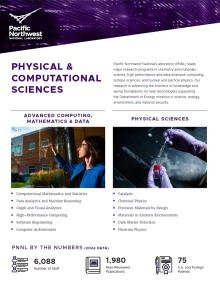 |
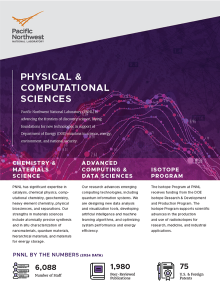 |
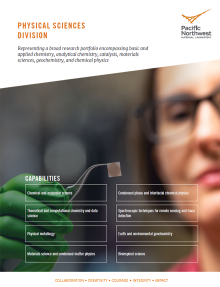 |
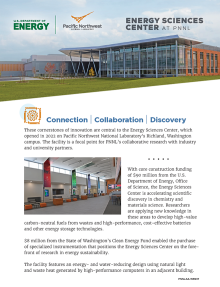 |